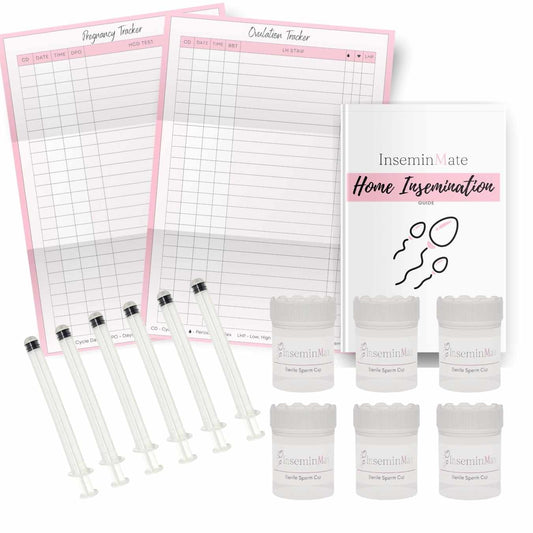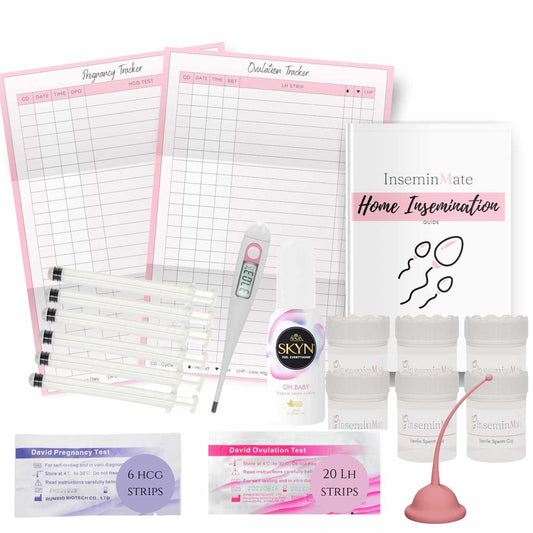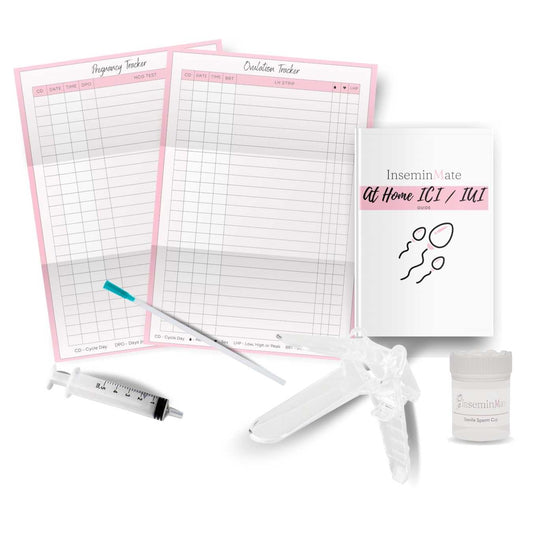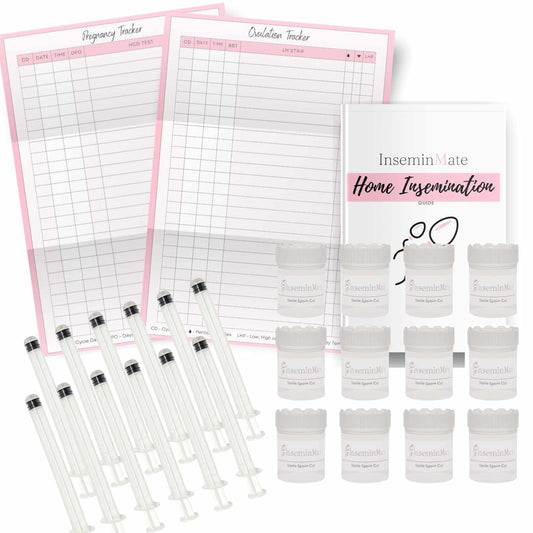At-Home Insemination
Discover what at-home insemination is, how to perform it safely, and get valuable tips for success. While this information empowers you, always consult a healthcare provider for personalized guidance on your fertility journey.
What is At-Home Insemination?
At-home insemination is a method employed by individuals and couples who wish to conceive without the need for clinical intervention. It involves introducing sperm into the female reproductive tract with the aim of fertilizing an egg, all within the comfort and privacy of one's home.
Key components of at-home insemination include timing intercourse to coincide with the female partner's fertile window and using various techniques and tools to facilitate the insemination process. This method is often chosen for its intimacy, flexibility, and affordability, allowing individuals and couples to take an active role in their family-building journey.
While at-home insemination can be a viable option for many, it's important to understand that success depends on several factors, including the health and fertility of those involved. Consultation with a healthcare provider or reproductive specialist is often recommended to ensure the best chances of achieving a successful pregnancy.
How to Perform At-Home Insemination
Performing at-home insemination can be a straightforward and intimate process when done correctly. Inseminmate at-home insemination kits, for instance, offer a comprehensive 20-page step-by-step guide to assist you throughout the process.
Step 1: Timing is Key
- The first crucial step in at-home insemination is understanding your menstrual cycle. The guide in the Inseminmate kit will help you determine your fertile window by tracking your ovulation.
Step 2: Gather Your Supplies
- Inseminmate kits come with the essential supplies you need for the process, including syringes, catheters, and collection cups. Make sure you have everything ready before you begin.
Step 3: Prepare Your Environment
- Choose a comfortable and private space in your home for the insemination process. Maintain cleanliness and hygiene, as outlined in the Inseminmate guide.
Step 4: Prepare the Sperm
- If you're using donor sperm, follow the instructions for preparing the sample. Inseminmate kits provide guidance on this as well.
Step 5: Follow the Inseminmate Guide
- Use the 20-page Inseminmate guide to perform the insemination process step by step. It will include details on how to load the syringe, insert the catheter, and deposit the sperm.
Step 6: Relax and Wait
- After insemination, it's important to relax and remain in a comfortable position for a designated time, typically outlined in the guide.
Step 7: Post-Insemination Care
- The guide will provide recommendations for post-insemination care, including any precautions or additional steps to take.
Step 8: Monitor and Test
- The Inseminmate guide may also include advice on how to monitor your cycle and when to take a pregnancy test.
By following the detailed instructions provided in the Inseminmate at-home insemination kit, you can ensure a safe and effective insemination process. These kits are designed to simplify the process and increase your chances of success, all within the privacy and comfort of your own home.
Is At-Home Insemination Right for You?
The decision to explore at-home insemination as a method for family planning is deeply personal and often comes after much consideration. If you're wondering whether at-home insemination is the right path for you, it's essential to weigh the factors and make an informed choice.
1. Consultation with a Healthcare Provider:
Before embarking on the journey of at-home insemination, it's strongly recommended to consult with a healthcare provider or fertility specialist. They can assess your individual circumstances and provide valuable insights into your fertility, ensuring that at-home insemination is a suitable option.
2. Fertility Factors:
Consider your fertility health. At-home insemination may be a viable choice for those who are generally healthy and have no underlying fertility issues. However, it's important to understand that it may not be the best option for everyone. If you have concerns about your fertility, consulting a specialist is crucial.
3. Partner or Donor Sperm:
The source of sperm plays a significant role in the decision. You might consider at-home insemination if you have a willing and suitable partner or if you're using donor sperm. Our "At-Home Insemination Starter Kit" can simplify the process, but the choice of sperm source should align with your family-building goals.
4. Comfort and Privacy:
At-home insemination offers intimacy, comfort, and privacy. If these factors are important to you and you prefer to manage the process in a familiar environment, at-home insemination might be the right choice.
5. Timing and Control:
With at-home insemination, you have the ability to time insemination according to your schedule and track ovulation with the help of ovulation tests. If you desire control over the timing and process, at-home insemination may align with your preferences.
6. Willingness to Learn and Follow Guidelines:
Successful at-home insemination requires following precise guidelines. If you're committed to learning and implementing the steps outlined in our included guide, it may be the right fit for you.
7. Support and Resources:
Having access to comprehensive resources and support, such as our "At-Home Insemination Starter Kit" with a step-by-step guide, can make the process more manageable and provide peace of mind.
Ultimately, the decision of whether at-home insemination is right for you is a personal one. We encourage you to seek professional guidance, evaluate your fertility health, consider your comfort and preferences, and ensure you have the necessary resources at your disposal. Our goal is to support you throughout your family-building journey, whatever path you choose.
Supplies and Equipment
When embarking on the journey of at-home insemination, having the right supplies at your disposal is essential to ensure a safe and effective process. Our comprehensive At-Home Insemination Starter Kit contains everything you need, making the experience more convenient and less stressful.
1. Insemination Syringe:
- The insemination syringe is designed for precise sperm placement, ensuring the best chances of conception. It allows for controlled and accurate delivery of sperm into the female reproductive tract.
2. Specimen Cup:
- A specimen cup is used for the collection and preparation of sperm, making it easier to transfer it into the syringe. Our kit includes a sterile, high-quality specimen cup.
3. At-Home Insemination Guide:
- A step-by-step guide is a crucial component of our kit, providing clear and detailed instructions on the insemination process. It offers guidance on timing, technique, and post-insemination care.
4. Ovulation Tests:
- To maximize your chances of success, our kit includes ovulation tests. These tests help you pinpoint your fertile window, ensuring that you're trying to conceive at the right time in your cycle.
5. Pregnancy Tests:
- Stay informed about your pregnancy progress with included pregnancy tests. These tests provide the peace of mind and confirmation you need when the time is right.
6. Lubricant:
- Our kit includes a fertility-friendly lubricant. This lubricant is designed to be sperm-friendly, ensuring it doesn't hinder the sperm's motility or viability during the insemination process.
7. Thermometer:
- Accurate temperature monitoring is crucial for tracking ovulation. Our kit contains a thermometer to help you pinpoint the most fertile days in your cycle.
With our At-Home Insemination Starter Kit, you'll have all the essential supplies at your fingertips, simplifying the process and increasing your chances of success. We're here to support you on your family-building journey, and our kit is designed to provide convenience and peace of mind during this important time in your life.
-
At Home Insemination 6 pack
Regular price €50,95 EURRegular priceUnit price per -
At Home Insemination Starter Kit
Regular price €103,95 EURRegular priceUnit price per -
At Home IUI ICI Insemination Kit
Regular price From €52,95 EURRegular priceUnit price per -
At Home Insemination 12 Pack
Regular price €103,95 EURRegular priceUnit price per








